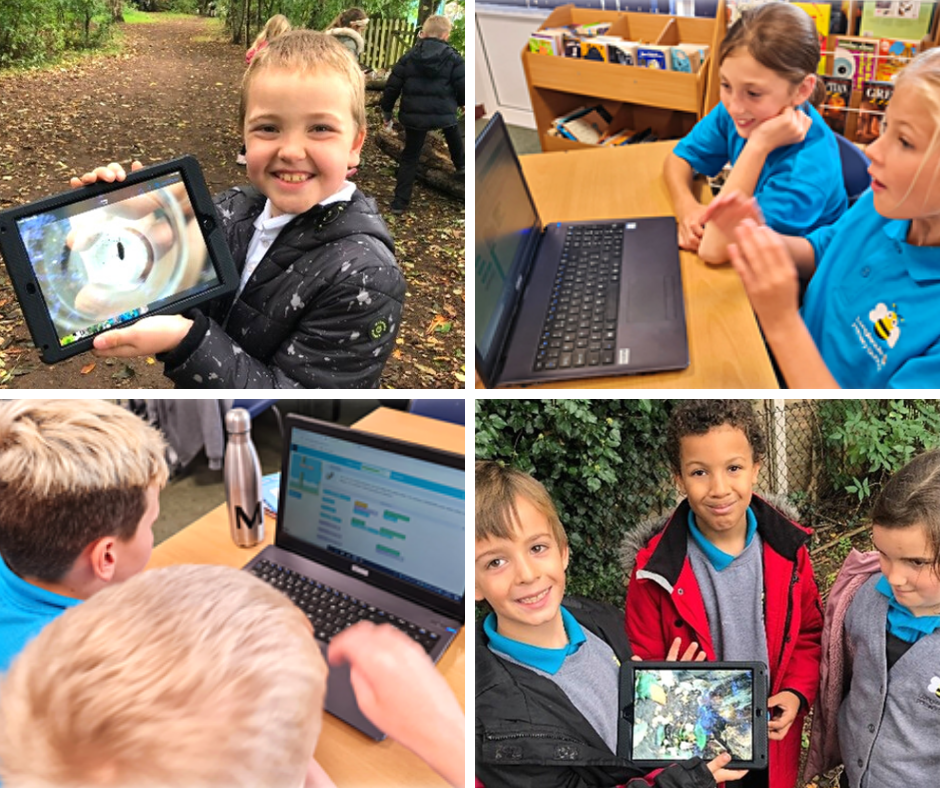Computing at Longlands Primary School
Intent
At Longlands Primary School, we acknowledge the pivotal role that technology currently plays, and will continue to play, in society. Therefore, we want to provide our children with the skills they need to flourish in a digital world. We aim to provide children with access to high-quality resources and teaching that equips them with the knowledge to work in the rapidly changing digital world and inspire them to pursue roles in the digital technology industry.
We have invested heavily in the technology we have available in school and offer the children access to iPads, computers and BenQ interactive displays. Computing is always part of our curriculum and is taught as both a stand-alone subject and as part of cross-curricular topics.
We utilise social media with our community Facebook and Twitter pages where we are able to celebrate children’s successes and keep our local community involved and informed about school life. This demonstrates how social media can be used positively. We encourage our children to become responsible digital citizens and emphasise the importance of online safety. Children are aware of how to keep themselves safe and how to report concerns about inappropriate content or cyber-bullying incidents
We aim to instil a sense of enjoyment around using technology and to develop pupil’s appreciation of its capabilities and the opportunities technology offers to create, manage, organise and collaborate. Tinkering with the software and programs help the children to develop confidence when encountering new technology. The computing curriculum enables pupils to meet the end of key stage attainment targets outlined in the national curriculum.
Implementation
Our computing curriculum covers each of the national curriculum attainment targets and is designed with three strands which run throughout:
- Computer Science
- Information Technology
- Digital Literacy
The curriculum progressively builds on previously taught knowledge and skills which develop year on year to ensure attainment targets are securely met by the end of each key stage.
Click here to view the Skills Progression.
The curriculum is organised into five key areas which create a cyclical route through which pupils can develop their computing knowledge and skills by revisiting and building on previous learning:
- Computer Systems and Networks
- Programming
- Creating Media
- Data Handling
- Online Safety
Lessons incorporate a range of teaching strategies from independent tasks, paired and group work as well as unplugged activities. This variety means that lessons are engaging and appeal to a wide variety of learning styles. Differentiated guidance is utilised in lessons to ensure that the lessons can be accessed by all pupils and more able pupils have the opportunity to extend their learning.
Computing is timetabled onto each class timetable weekly to ensure that the units are revisited regularly and to keep the children engaged. Classes have a regular timetabled slot weekly where they have access to laptops and iPads.
E-Safety is taught through explicit lessons using Project Evolve which forms part of our RSE curriculum and during E-Safety Week across school. Any issues that are brought to the attention of teachers are also re-visited in a timely manner in class.
Click here for our Long-Term Curriculum Plan.
Impact
Our computing curriculum gives children the opportunity to access a wide range of resources and to develop their skills in typing, word processing, blogging, coding and much more. The curriculum is fun, engaging and is enjoyed by all learners.
We measure the progress made by our children through discussions with them about the key computing vocabulary used and by observing their ability to complete tasks independently or with support. Another way in which we are able to assess the children is by observing how they apply the skills learnt in computing to other areas of the curriculum such as English, Maths and Art. The impact of the computing curriculum is monitored through both formative and summative assessment opportunities. During each lesson teachers in assess pupils against the learning objectives and each unit has a quiz and knowledge catcher which can be used at the start and end of the unit.
After the implementation of teaching computing, pupils should leave school equipped with a range of skills to ensure they succeed in their secondary education and be safe, active participants in the ever increasing digital world.
The expected impact of our computing curriculum is that children will:
- Be critical thinkers and be able to understand how to make informed and appropriate digital choices in the future.
- Understand the importance that computing will have going forward in both their educational and working life for both their personal and social futures.
- Understand how to balance time spent on technology and time spent away from it in a healthy and appropriate manner.
- Understand that technology helps to showcase their ideas and creativity. They will know that different types of software and hardware can help them achieve a broad variety of aims.
- Show a clear progression of technical skills across all areas of the national curriculum – Computer Science, Information Technology and Digital Literacy.
- Be able to use technology both individually and as part of a collaborative team.
- Be aware of online safety issues and be able to deal with problems in a responsible and appropriate manner.
- Meet the end of key stage expectations outlined in the national curriculum for computing.
Click here to see the Progression of Vocabulary for Computing.

Computing at Longlands Primary School

